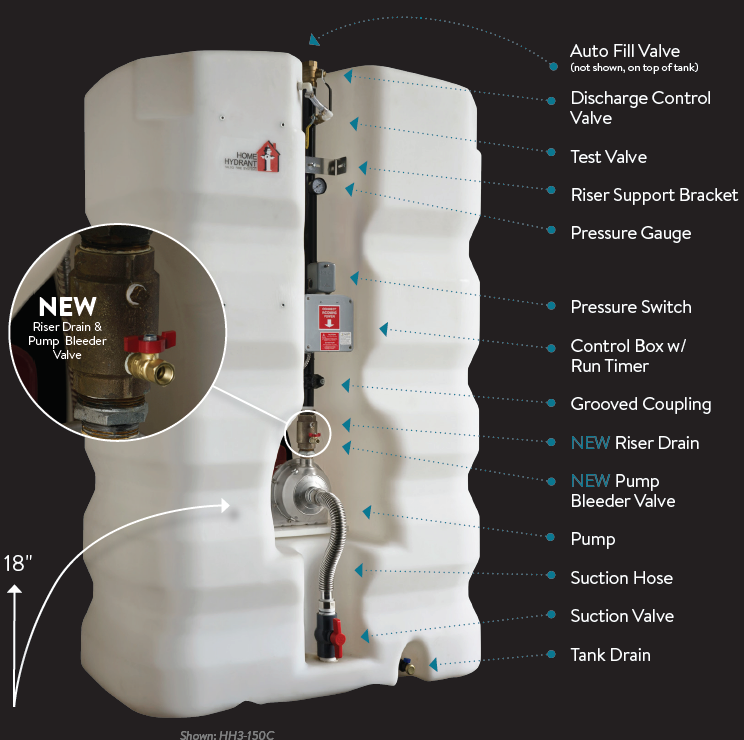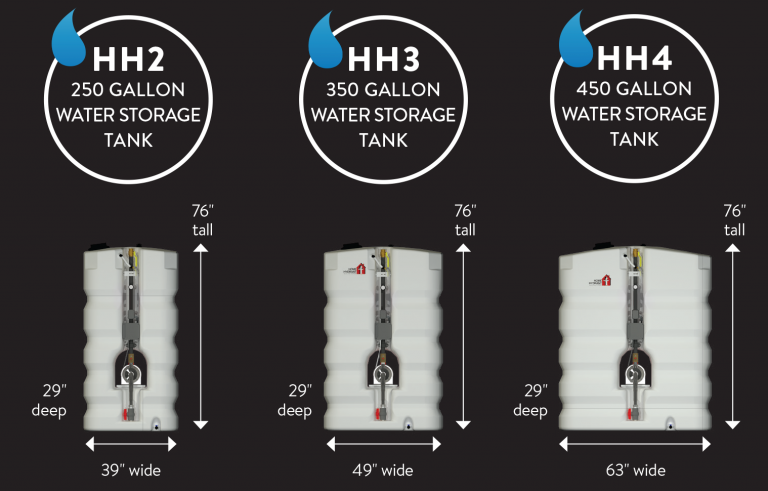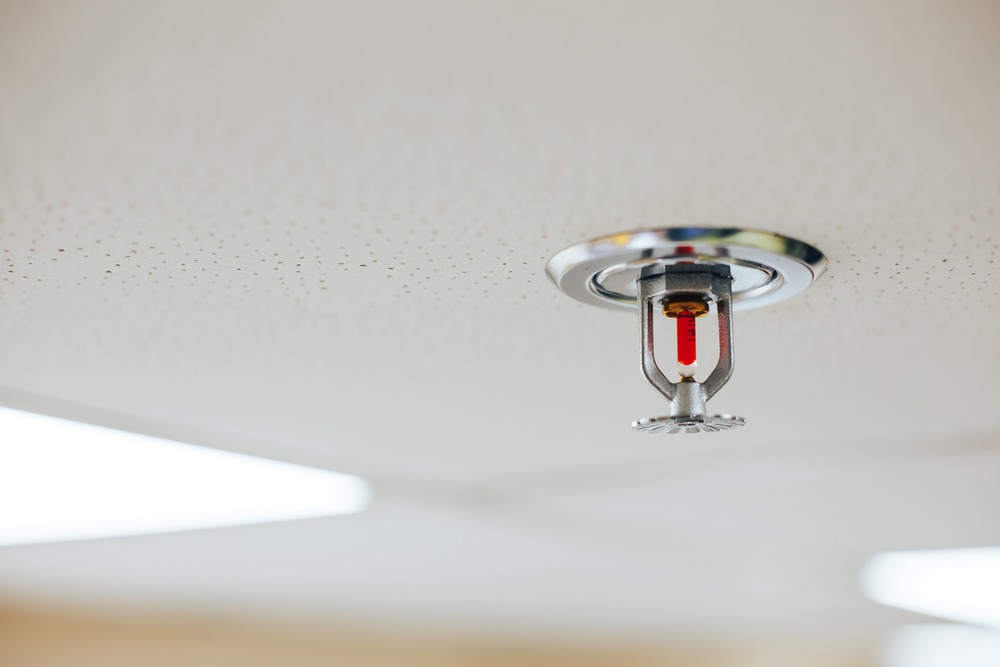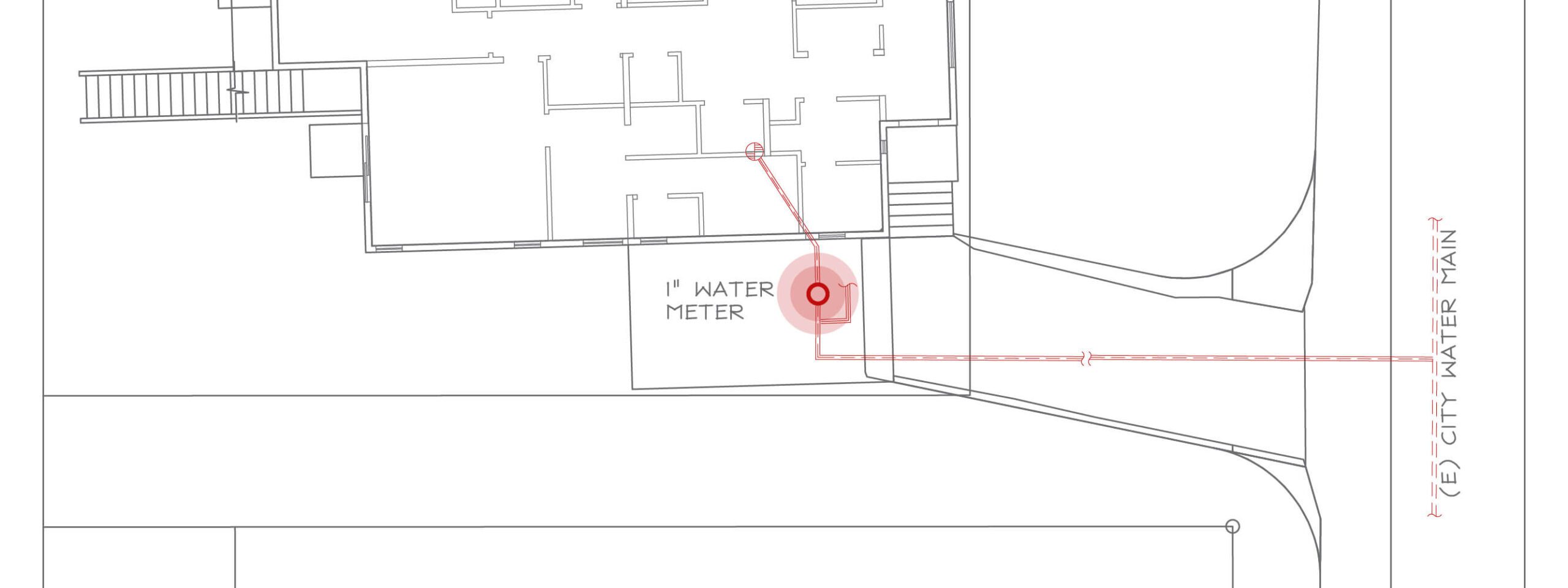Fire Sprinkler Design Solutions: The All-in-One Tank and Pump
What is a Home Hydrant?
A Home Hydrant conveniently combines three sprinkler system elements in one location. Let’s explore each in closer detail.

Figure 2: Breakdown of a TalcoFire HH3 tank with labeled components including pump, valves, and control box (Source: TalcoFire)
- Water Storage Tank: an average residential sprinkler system will typically require around 260 gallons of water supply total. To learn more about how we arrive at this number (and the exceptions to this rule), see our article, Water Supply for Residential Fire Sprinkler Systems. Whatever the total required gallonage for a sprinkler system may be, the Talco pump company offers the Home Hydrant in three storage tank sizes; 250 gallons, 350 gallons, and 450 gallons. These three options should cover the water quantity requirements of the wide majority of residential sprinkler systems.
- Fire Booster Pump: the water supply inside the storage tank must be pressurized to such a degree as to push water through the most remote sprinklers in the system. Depending on the model chosen, the integrated pump component of the HH can provide up to 60 psi and up to 60 gpm. This pump also fully complies with the fire pump requirements of NFPA 13D §6.2.1.
- Fire Sprinkler Riser: the Home Hydrant eliminates the need to build a separate fire riser; the unit is essentially plug-and-play. The installer can simply connect their overhead sprinkler pipe directly to the outlet at the top of the HH. The Home Hydrant riser offers all the required components of a standard riser, such as a control valve, flow switch, inspector’s test assembly, etc.
The appearance of a convenient all-in-one tank and pump was significant in the fire protection world. Historically a fire sprinkler contractor’s only option was to source and construct each component separately.
Example Design Scenarios
The following are examples of real-world sprinkler projects in which the Home Hydrant offered a solution to a tricky water supply issue.
- An older house with an antiquated water supply is being remodeled and requires a new sprinkler system. The existing underground line is a meager 3/4” in diameter, and the existing water meter is a similarly paltry 5/8” in size. In addition to these design challenges, the house sits 20 feet higher than the water source, expanding the water pressure requirements even further.
This existing water infrastructure stifles the available municipal water pressure to such an extent that even the most efficient sprinkler design cannot function. The local water district gives the homeowner the option to upgrade the water meter and supply line, but this will cost tens of thousands of dollars. As an alternative, a Home Hydrant was placed in the basement to supply the sprinkler system, bypassing the need to rely on municipal water and ultimately saving the homeowner both time and money.
- An accessory dwelling unit is being built on a site with an existing house supplied by a well. When the well is tested, it is discovered that the well pump provides only 15 gpm. 15 gpm is plenty of flow for domestic water usage, but will not be enough to supply the average sprinkler system. The homeowner prefers not to upgrade the well pump nor to assemble a separate storage tank and pump just for the sake of the sprinkler system. It was determined that the most cost-effective option for the homeowner was to install a Home Hydrant in the well shed to supply the ADU sprinkler system.
- A custom-built house has some unique design elements such as extremely steep ceiling slopes, especially deep exposed beams, and/or a beamed Great Room over 600 ft² in size. According to NFPA 13D §10.2.1 and the local fire authority having jurisdiction, three or four remote sprinklers will need to be hydraulically calculated instead of two, increasing the pressure and flow requirements of the system significantly. What would have been an adequate water output from the municipal supply is now insufficient. The homeowner opts to go with a simple and quick method of upgrading their sprinkler water supply–the Home Hydrant.
- A homeowner is storing a collection of valuable items in their home and is concerned about potential water damage from the sprinkler system. A system supplied by the city’s water could plausibly run for hours, flooding the house with thousands of gallons of water before eventually being shut off. The small tank size of the HH ensures that only a couple hundred gallons could possibly be discharged into a home.

Figure 3: TalcoFire HH2, HH3, and HH4 water tanks compared by height, width, depth, and gallon capacity (Source: TalcoFire).
Additional Notes about the Home Hydrant
- Typically, a unit like the Home Hydrant is dedicated to supplying a fire sprinkler system only. However, Talco also offers potable HH models for those who would like to combine their domestic and sprinkler systems.
- Where does the HH get installed? These tanks should be installed indoors in a room such as a utility closet to provide protection from the elements and tampering.
- The tank itself will still need to be fed from a water source, either from the municipal or well supply. Per NFPA 13D §6.2.2, a method for refilling the tank shall be piped to the tank.
Conclusion
As much as we would like it to be the case, a perfect supply of water pressure and flow doesn’t always exist for our sprinkler systems. Perhaps you or someone you know have experienced a restricted water supply scenario similar to those outlined above. In such cases, the Home Hydrant is a useful solution to consider–furnishing not only the pressure and flow we require, but also the simplicity needed to get our systems operational, inspected, and approved more swiftly.



